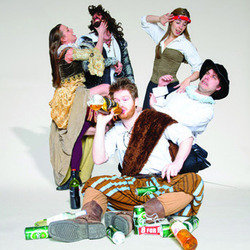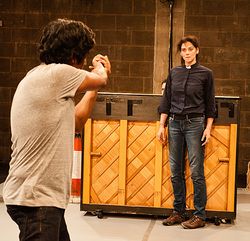
by Sam Wend
Tonight, a group of us went to see Shit-Faced Shakespeare at C. The performance was 24 minutes late getting started, which was pretty frustrating since we had to queue up outside in the cold night air for the majority of that time, and we knew the only way any show could get away with starting that late was because it was the last one in the space for the night. But despite that, despite having to pay for tickets at a venue where we had passes, and despite going all the way there only to find out it was sold out yesterday – the show was 110% worth it.
The concept of Shit-Faced Shakespeare, a Magnificent Bastard Productions tradition, is that a troupe of professional Shakespearean actors perform a Shakespeare play – this year, it’s Much Ado About Nothing. The catch is that at each performance, one of the actors is randomly selected to be totally, completely wasted. The same actor cannot be picked two nights in a row, and no one can do it for more than four performances a month, as a way to protect both the livers of the actors and the integrity of the show.
It was absolutely hysterical; the edges of my mouth still ache a bit from smiling so much. The girl who played Hero, the smallest, lightest-weight person in the cast, was selected as the shit-faced Shakespearean of the evening. Highlights of the show, which was excellent even beyond the drunken element, included: Hero bringing her cell phone onstage and making the entire audience sing “Happy Birthday” to her sister over voicemail; Claudio pulling a woman out of the front row to stand in as Hero when she got distracted backstage, and Hero mocking and staring the girl down for the rest of the performance; Hero dying at least three times because she couldn’t remember when in the wedding scene it was supposed to happen; a fantastic soundtrack of modern music given a medieval twist; Margaret being portrayed by a teenage boy pulled from the audience; Hero constantly asking the stage manager to change cues and the rest of the actors wondering who the mysterious Maria in the sky was; and Hero calling Claudio a “dirty man” and apologizing to Maria for her husband (Claudio) cheating on her when Claudio and Hero kissed as part of the show.
If I had unlimited time and money and the show wasn’t selling out every night, I would be more than happy to see this production every single evening. I can’t imagine it ever getting boring, since by nature it becomes a completely different performance every evening. Despite the goofiness and insanity of the idea, the support and passion amongst the actors and Maria was clear, and it was wonderful to see them work together and support each other, somehow getting through the show despite the many (comedic) distractions and deterrents.
Tonight, a group of us went to see Shit-Faced Shakespeare at C. The performance was 24 minutes late getting started, which was pretty frustrating since we had to queue up outside in the cold night air for the majority of that time, and we knew the only way any show could get away with starting that late was because it was the last one in the space for the night. But despite that, despite having to pay for tickets at a venue where we had passes, and despite going all the way there only to find out it was sold out yesterday – the show was 110% worth it.
The concept of Shit-Faced Shakespeare, a Magnificent Bastard Productions tradition, is that a troupe of professional Shakespearean actors perform a Shakespeare play – this year, it’s Much Ado About Nothing. The catch is that at each performance, one of the actors is randomly selected to be totally, completely wasted. The same actor cannot be picked two nights in a row, and no one can do it for more than four performances a month, as a way to protect both the livers of the actors and the integrity of the show.
It was absolutely hysterical; the edges of my mouth still ache a bit from smiling so much. The girl who played Hero, the smallest, lightest-weight person in the cast, was selected as the shit-faced Shakespearean of the evening. Highlights of the show, which was excellent even beyond the drunken element, included: Hero bringing her cell phone onstage and making the entire audience sing “Happy Birthday” to her sister over voicemail; Claudio pulling a woman out of the front row to stand in as Hero when she got distracted backstage, and Hero mocking and staring the girl down for the rest of the performance; Hero dying at least three times because she couldn’t remember when in the wedding scene it was supposed to happen; a fantastic soundtrack of modern music given a medieval twist; Margaret being portrayed by a teenage boy pulled from the audience; Hero constantly asking the stage manager to change cues and the rest of the actors wondering who the mysterious Maria in the sky was; and Hero calling Claudio a “dirty man” and apologizing to Maria for her husband (Claudio) cheating on her when Claudio and Hero kissed as part of the show.
If I had unlimited time and money and the show wasn’t selling out every night, I would be more than happy to see this production every single evening. I can’t imagine it ever getting boring, since by nature it becomes a completely different performance every evening. Despite the goofiness and insanity of the idea, the support and passion amongst the actors and Maria was clear, and it was wonderful to see them work together and support each other, somehow getting through the show despite the many (comedic) distractions and deterrents.



 RSS Feed
RSS Feed
